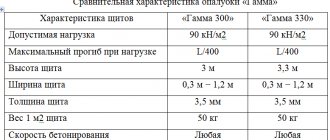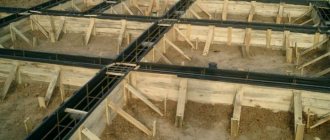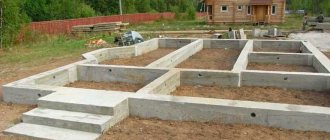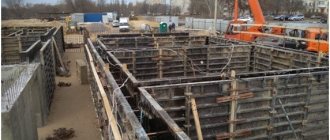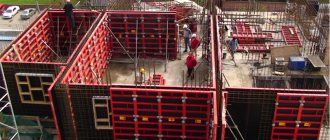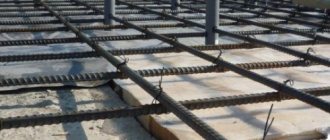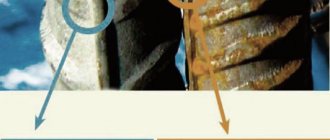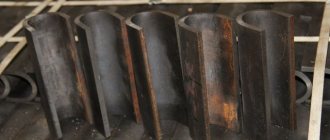Couplings for reinforcement are an assembly element that replaces welding or fastening of rods with binding wire. By type they are divided into two main groups: threaded and crimped. This connection method is innovative. It simplifies the assembly process, allows you to eliminate defects and build up additional areas. With strict adherence to technology, it ensures the reliability of the finished structure.
The coupling connection of the reinforcement does not require the additional use of fasteners and reduces the installation time of the reinforcement cage. The affordable price allows them to be used even for low-rise construction.
Couplings for reinforcement - an assembly element that replaces welding or fastening of rods with binding wire
What it is?
The technology for assembling products from reinforcing bars involves the use of couplings. This ensures savings in rolled metal.
There are two main types of couplings:
- threaded (screwing on the connecting reinforcing bars is required);
- crimping (requires special equipment for crimping).
Each group includes several subtypes of couplings, differing in design nuances and joining methods. Installation using threaded couplings ensures strength and less material consumption (savings up to 20%). Unlike the strapping method, it does not increase the reinforcement structure.
Elements are used to directly connect parts. A reliable, cost-effective option for mounting the frame is provided. Standard sizes of couplings, types and parameters of materials used are regulated by GOST 10922-2012.
Connecting reinforcement using a coupling
Features of the structure of reinforcing couplings
If you have encountered the reinforcement of reinforced concrete frames, you should know how much time and effort this process takes, while construction work must be completed exactly on time. Reinforcing couplings perform the same role as wire and welding - they are used to directly connect reinforcement, while the reliability of the connection is significantly increased. There is also a real saving in fittings, and installation time is significantly reduced. Two types of reinforcing couplings are used:
- threaded with screwing of the fittings into the coupling cavity;
- crimping, the use of which requires the presence of special equipment.
In monolithic frame and other branches of construction, various types of couplings are used, differing in size and other parameters, and the choice is made in strict accordance with the requirements of GOST 10922-2012. The reinforcement is fastened directly in the work area, the process takes a few minutes, and special knowledge and special equipment are often not required. And this is not counting the savings in materials, and studies show that the use of couplings for fittings reduces the consumption of the latter by approximately 20%.
Features and purpose
Couplings are often used in combination with other fastening or locking elements:
- limiters;
- valves;
- valves.
The couplings create a high-quality connection because they are made of a material of the same strength as the reinforcing bars.
Scope of application of couplings:
- installation of reinforcement cages during the construction of foundations;
- assembly of metal frames during the construction of multi-story and low-rise buildings, bridges, industrial buildings, power plants.
Couplings for connecting reinforcement are used for fragmentary elimination of joints.
Purpose of couplings for fittings
Reinforcing couplings have a cylindrical shape, and the length of the cylinder, as well as the diameter of the products, can differ significantly. These hollow parts are made of reliable steel, which is not inferior in strength to the reinforcement itself. Couplings are perfectly combined with other locking structures: valves, gate valves and limiters. As for the scope of application, this is mainly the assembly of reinforced structures during the construction of foundations and load-bearing walls. Reinforcing couplings are used in housing construction; they are indispensable in the construction of bridges, power plants and other critical structures.
Operating principle and design
Depending on the type, couplings have their own design features and methods of application. Small diameter pipes are used to produce couplings. Inside there is a smooth surface (for crimping types) or a pipe microthread with an inch pitch is applied. The outer connecting end is made in the shape of a polyhedron. Threads are created in various ways: rolling, stamping, etc.
Connecting couplings for fittings
The edges of the connected rods are placed inside the coupling, after which they are joined end-to-end by screwing onto the thread and secured with studs. Position couplings are used to connect reinforcing bars of different diameters. They are used for direct and transverse connections of straight or curved reinforcement. The cost of assembling the structure is included in the planning and preparation of the general estimate.
Types of connection equipment
The equipment for joining depends on the type of coupling used and the location of work. There are 2 types of machines available: for crimping and threaded fastening.
For crimping under construction conditions, mobile hydraulic presses are used, consisting of: a press, an oil station and high-pressure hoses. The press operates in semi-automatic mode. Control is carried out from a remote control built into the handle or manually.
Using a portable press, mechanical crimp fasteners form a reinforcement joint with high tensile strength. At the same time, the actual force to the temporary resistance of the compressed rolled product increases significantly and unlimited endurance is guaranteed.
Machine for thread cutting on fittings
The machines are designed to prepare joints for subsequent coupling fastening. They are applicable to rods with a diameter of 16 to 40 mm. Provide a maximum thread length at the outlet of up to 80 mm.
Depending on the cutting, there are 2 types of machines:
- For conical cutting. Mechanism of action: removing excess body from the reinforcement with cutters, followed by giving it a cone shape and cutting. Productivity - up to 1000 notches per shift.
- For cylindrical knurling. The reinforcement ribs are cut with cutters, and the notches are rolled with rollers. Can be used directly on a construction site with a productivity of 400 threads per shift.
Crimping machine
The machines provide a complete set of crimping technology. The system connects reinforcement in the range of 16-55 mm. The kit includes replacement dies for different rod diameters. The standard machine consists of the following components:
- Reinforcement press (stationary or portable).
- Pumping station.
- Winch for moving the press relative to the coupling.
- High pressure hose.
The machine creates a fastening that is identical in strength to a reinforcing bar. Managed by one operator. Can be used in any position in space.
What fitting couplings do you use?
Threaded
Crimping
Advantages and disadvantages
Couplings for structural connection of reinforcement have the following advantages:
- multifunctional connection of metal elements in different directions (horizontal, vertical or inclined arrangement);
- the crimp design of the couplings provides a uniform connection by crimping the ends (does not require preliminary threading);
- the construction time of a monolithic structure is reduced;
- the metal frame can be mounted regardless of the parameters of the structure being constructed;
- ease of design quality control;
- no welding work is required, including highly qualified welding;
- the cross-section of metal reinforcement has a small area;
- the load is distributed evenly over the entire area of the structure being constructed;
- for assembling reinforcing elements of metal frames, special tools and equipment are not required (in the case of threaded couplings);
- there is no need for a limit on the coupling connection of the pins.
As a result, the entire structure is a single metal pin. The frame retains its integrity even if the concrete structure is destroyed.
Mechanical connection of reinforcement using a coupling
Disadvantages of a coupling connection:
- reduction in strength and reliability of installation during thread cutting (reduces the overall thickness of the structure);
- screwing on a coupling with an internal gasket requires some physical effort.
The greatest difficulty is the use of crimp couplings. Application features include:
- increase in the weight of the mounted structure;
- the use of heavy hydraulic presses during the installation process;
- the impossibility of repeating the connection even for one casting of rolled metal;
- the deformability requirement is not met.
Crimping fittings is a technology that has disadvantages. Among the main ones is the inability to maintain the declared quality level when operating conditions change.
Advantages of reinforcing couplings
When mentioning the advantages of reinforcing couplings, first of all it is worth highlighting their functionality, or the ability to connect products located horizontally and vertically, as well as reinforcement inclined at different angles. When it comes to crimping products, fast installation is worth highlighting, since in this case there is no need for thread cutting.
Thanks to the mechanical coupling connection, construction time is significantly reduced, since the installation of couplings is carried out quickly. The load is distributed evenly, while the entire structure of the reinforced belt is a single steel frame, and the integrity of the structure is maintained even after the failure of the reinforced concrete base.
Types of coupling fastenings
Coupling connections involve various options for joining reinforcing bars:
- couplings with conical thread type;
- parallel thread couplings;
Coupling connections for Ancon MBT fittings
- bolt type couplings;
- crimp couplings for fittings.
Couplings designed for connecting metal structures have several varieties:
- transitional (for sequential joining of rods having different diameters);
- bolted (for connecting reinforcement using special friction linings);
- positional (for high-speed connection of reinforcement of various shapes: straight, curved and curved rods).
If couplings without threads are required, crimp options for connecting reinforcement are mounted from steel pipes.
Coupling design
Mechanical couplings have the following design features:
- couplings with conical threads are manufactured on mobile threading machines;
- couplings with parallel threads have smaller dimensions compared to other varieties;
- The crimp coupling does not require special equipment to form threads.
Crimp couplings require subsequent mechanical pressing of each joint. Couplings are made from small-diameter pipes, due to which the finished joint is slightly thickened.
Crimp couplings require subsequent mechanical pressing of each joint
Home > Articles > Connecting couplings for fittings
Saturday, September 5, 2015
For a long time, experts have been trying to solve the problem of joining reinforcing bars at construction sites. The simplest method is an overlap connection without welding. This method is unprofitable due to the large overconsumption of rolled metal. Connecting material by welding is quite labor-intensive and entails an increase in the cost of work. Today, one of the most promising joining systems are couplings for fittings, which have different properties and have their own advantages. The products are widely used in the construction of multi-storey buildings, bridges, and hydroelectric power stations.
Couplings are a reliable, high-quality, and inexpensive method of creating durable metal frames for modern structures. In the process, a butt connection of the reinforcing rod occurs with a crimped coupling. As a result, the bending and shear strength of the created unit is in no way inferior to the parameters of a solid section of reinforcement. The use of such products allows for fragmentary removal of joints in reinforcement ties. This type of assembly completely eliminates all the flaws in the welding assembly of frames and the binding of metal rods.
This docking method provides:
- Equal strength joint;
- Good work performance;
- Availability of consumables;
- Allows you to carry out work regardless of weather conditions.
Kinds:
- Transition couplings. They are used when joining rolled metal of the same diameter;
- Positional couplings are designed for quick connection of fittings of various configurations. The products are successfully used for the installation of prefabricated frames. They are equipped with a plastic plug for optimal protection of the joint;
- An end anchor is an alternative option. The front part has a large margin of strength and stability, so the products can withstand tensile loads that arise when the metal rod is exposed to the base;
- Bolt couplings provide a smooth transition from the rod shaft to the threaded stud. This type of product is suitable for creating long ties;
- Welded couplings for fittings are used to reliably connect rods to the metal of the structure.
Peculiarities
For the production of these products, small diameter pipes are used. The products have internal microthreads of a certain diameter, and the outer ends are formed as a turnkey polyhedron. The microthread of the coupling is inch with a small pitch. The main indicator of the quality of a connection is its strength with the base material.
Couplings for connecting fittings can be used with locking elements: valves, gate valves, limiters. As a rule, crimping elements form a strong, uniform joint between 2 pins using a clamp without special processing of the ends. This technology guarantees high-quality connections and a permanent joint system in rigid blocks. To make such a connection, a special device is required, as well as hydromechanical equipment.
When using a coupling connection:
- The consumption of metal rods is reduced;
- Little skilled labor is used;
- Electricity consumption is reduced;
- The cost of consumables is reduced.
Although couplings do not require additional fasteners, they have a number of disadvantages: when cutting threads, the strength and reliability of installation are reduced, which entails a reduction in the thickness of the walls of the structure. Thin-walled pipes are completely unsuitable for this type of thread processing. This technology is used only for products with thick walls. It should be noted that this will require a lot of effort to screw the coupling onto the thread along with the gasket.
Assembly technology
The assembly process itself involves crimping. At the first stage, the part of the coupling in which the metal rod is installed is crimped. And to crimp the other edge, the uncrimped end of the rod is inserted. It should be noted that the lengths of the two parts of the product must be in a certain ratio. This joining technology involves crimping using 2 couplings. Couplings for mounting reinforcement are an affordable alternative to the overlap method, since the product minimizes the overconsumption of rolled metal and significantly reduces costs.
Advantages of couplings:
- Possibility of placing the metal structure in several positions;
- The cyclical nature of the frame installation process;
- Quick assembly of the structure;
- There is no need to perform qualified welding work;
- At the joint section, the reinforcement section contains a minimum area;
- Threads are created using stamping and rolling.
Features of the application of innovative technology
The innovation of using a coupling connection is that it provides better quality compared to a welded connection.
Advantages of using couplings:
- does not require complex welding equipment;
- material costs for the construction of joints are reduced;
- the speed of connecting reinforcing bars increases up to 10 times.
An equal-strength connection of rods increases the nominal strength of the reinforcement. This joining method does not affect the strength of the reinforcing bar.
Installation technology
The algorithm for installing a metal frame using couplings includes several stages.
- The coupling is installed on a pre-marked reinforcement section.
- The holes of the couplings with internal threads are closed with plastic caps.
Coupling installation technology for connecting reinforcement
- The ends of the cut reinforcing bars are covered with rubber caps. For threaded couplings, threads are cut or rolled on the rods.
- Before putting the coupling on the rod, tighten the connection with a wrench.
When connecting with crimp-type elements, special equipment will be required. Technology includes:
- assembly of crimping devices on rods;
- pressing of units using a portable hydraulic press.
Afterwards, a visual inspection of the connections is carried out and their quality is controlled.
Results
Joining reinforcing bars with special couplings is an optimal alternative to assembly using the overlap method or welding. This technology simplifies the frame installation process and ensures durability.
Mechanical elements are divided into two main groups: threaded and crimped. Each of them has several subspecies, which have their own manufacturing and installation features.
When using connecting elements, you need to know how corner reinforcement and reinforcement of a pile-strip foundation are carried out. You already know the answer to the question whether it is possible to weld reinforcement for the foundation, as well as the nuances of manufacturing reinforcement cages.
Assembling a metal frame reduces the labor intensity of the process and is used to build up or correct structural elements in the future. There is also an alternative option - plastic reinforcement: the pros and cons of using this material will be interesting to know for those who start construction on their own.

